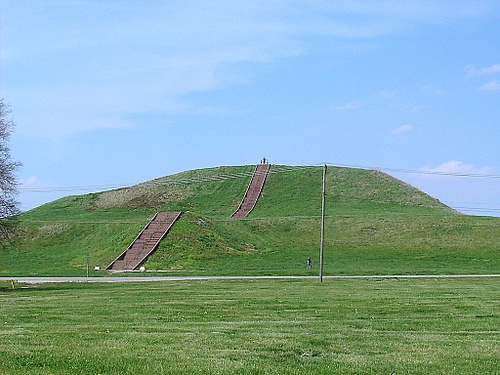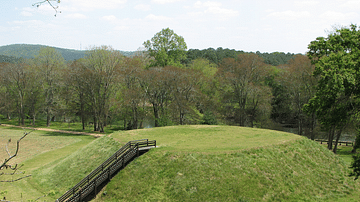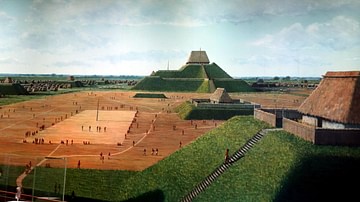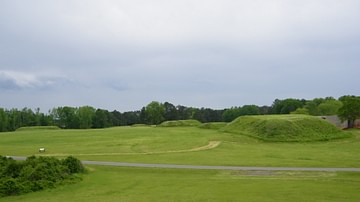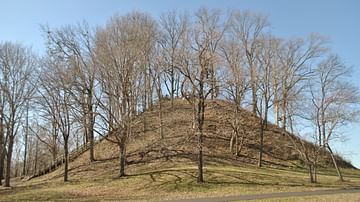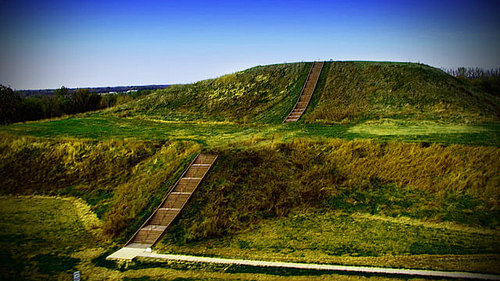
Cahokia is a modern-day historical park in Collinsville, Illinois, enclosing the site of the largest pre-Columbian city on the continent of North America. The original name of this city has been lost – Cahokia is a modern-day designation from the tribe that lived nearby in the 19th century – but it flourished between c. 600-c. 1350 CE.
The city seems to have initially grown organically as more people moved into the region (at its height, it had a population of over 15,000 people) but the central structures – the great mounds which characterize the site – were carefully planned and executed and would have involved a large work force laboring daily for at least ten years to create even the smallest of the 120 which once rose above the city (of which 80 are still extant). The city flourished through long-distance trade routes running in every direction which allowed for urban development. There was a wide plaza for merchants, a residential area for the common people and another for the upper-class, a ball court, a playing field for the game known as Chunkey, fields of corn and other crops, solar calendar of wooden poles, and the mounds which served as residences, sometimes graves, and for religious and political purposes.
For many years, it was thought that the people of Cahokia “mysteriously vanished” but excavations from the 1960’s to the present have established that they abandoned the city, most likely due to overpopulation and natural disasters such as earthquakes and floods, and that it was later repopulated by the tribes of the Illinois Confederacy, one of which was the Cahokia. In the present day, Cahokia is a UNESCO World Heritage Site and ongoing archaeological site covering 2,200 acres (890 ha) visited by millions of people from around the world every year.
The Mississippian Culture & Mounds
The modern-day designation Mississippian Culture refers to the Native American people who inhabited the Mississippi River Valley, Ohio River Valley, and Tennessee River Valley, primarily, but were spread out in separate communities all the way down to present-day Louisiana as well as points north and east. The two best-known are the Adena Culture (c. 800 BCE-1 CE) and the Hopewell Culture (c. 100 BCE-500 CE) whose tribes inhabited modern-day Virginia, West Virginia, Ohio, Pennsylvania, Kentucky, and Indiana. The names of both are modern-day designations: Adena was the name of the 19th century Ohio Governor Thomas Worthington’s estate outside Chillicothe, Ohio where an ancient mound was located and Hopewell was the name of a farmer on whose land another, later, mound was discovered.
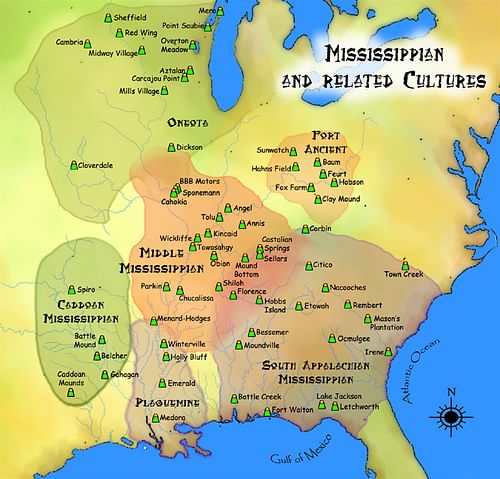
Although the communities seem to have been diverse in crops grown and crafts produced, they all built large earthen mounds which served religious purposes in elevating the chiefs, who may also have been priests, above the common people and closer to the sun, which they worshipped as the source of life. The ruler of the city called himself "Brother of the Sun" and worked with the priests in honoring all the gods and spirits of the unseen world. The religious beliefs of the Mississippian peoples, as well as Native Americans in general, are summarized by scholar Alan Taylor:
North American natives subscribed to “animism”: a conviction that the supernatural was a complex and diverse web of power woven into every part of the natural world. Indeed, Indians made no distinction between the natural and the supernatural. In their minds, spiritual power was neither singular nor transcendent, but diverse and ubiquitous. Their world was filled with an almost infinite variety of beings, each possessing some varying measure of power. All living things belonged to a complex matrix that was simultaneously spiritual and material. Indeed, spirit power could be found in every plant, animal, rock, wind, cloud, and body of water – but in greater concentration in some than others. (18)
It is thought that the Mississippian peoples built their mounds to focus spiritual power in a central location in their communities. The priests or priest-kings who performed rituals on these mounds were believed to be able to harness this power to protect the people and ensure regular rainfall and bountiful harvests. The earliest mound dated thus far is the Ouachita Mound in Louisiana which was built over 5,400 years ago and later mounds have been discovered from Ohio down to Florida and the east coast to the Midwest. No one knows what these people called themselves, but they are frequently referred to as “Moundbuilders” since their culture is characterized chiefly by the mounds they left behind. Scholar Charles C. Mann describes the variety of the mounds:
Most of the earthworks were shaped like big cones and stepped pyramids, but some were sculpted into enormous birds, lizards, bears, long-tailed “alligators” and, in Peebles, Ohio, a 1,330-foot-long serpent…None of the mounds cover burials or contain artifacts or show signs of use. Indeed, they seem to have [had] little purpose. (290-291)
Mann emphasizes the seems because, as he explains, the mounds “testify to levels of public authority and civic organization” because “building a ring of mounds with baskets or deerskins full of dirt is a long-term enterprise” requiring a central authority capable of delegating tasks and overseeing aspects including logistics, food supply, housing, and work shifts (291-292). The authority figures of the Adena and later Hopewell cultures were also responsible for the cultivation of tobacco which was used in religious rituals which took place at the top of these mounds, out of sight of the people, or on artificial plateaus created in the center or below the mound where public rituals were enacted.
Rise of Cahokia & the Great Mound
The Hopewell Culture is the immediate predecessor to the people who built Cahokia but the two are not thought to have been the same. One notable distinction is in the crops they grew. The Adena/Hopewell cultivated barley, marsh elder, may grass, and knotweed, among others while the people of Cahokia had discovered corn, squash, and beans – the so-called “three sisters – and cultivated large crops of all three. Cahokia is thought to have begun as just another small village, one of many, located between a forest and a river on a wide plain conducive to agriculture. How it developed is unknown but archaeologists who have worked at the site claim it was most likely the construction of the largest mound – known as Monk’s Mound today – that brought people from other communities to the new city.
The religious authorities are thought to have sent out word that they were going to build a great mound and, according to one view, people from many different regions came to participate; according to another, the central authority conscripted workers from other communities as forced labor. This second theory has been challenged, however, in that there is no evidence of enslaved peoples at the site. Mann cites geographer and archaeologist William Woods of the University of Kansas, who has excavated at Cahokia for over 20 years, in describing the construction of the great mound:
Monks Mound [so-called for a group of Trappist monks who lived nearby in the 18th and 19th centuries] was the first and most grandiose of the construction projects. Its core is a slab of clay about 900 feet long, 650 feet wide, and more than 20 feet tall. From an engineering standpoint, clay should never be selected as the bearing material for a big earthen monument. Clay readily absorbs water, expanding as it does. The American Bottom clay, known as smectite clay, is especially prone to swelling: its volume can increase by a factor of eight. Drying, it shrinks back to its original dimensions. Over time, the heaving will destroy whatever is built on top of it. To minimize instability, the Cahokians kept the slab at a constant moisture level: wet but not too wet. Moistening the clay was easy – capillary action will draw water from the floodplain, which has a high water table. The trick is to stop evaporation from drying out the top. In an impressive display of engineering savvy, the Cahokians encapsulated the slab, sealing it off from the air by wrapping it in thin, alternating layers of sand and clay. The sand acts as a shield for the slab. Water rises through the clay to meet it, but cannot proceed further because the sand is too loose for further capillary action. Nor can the water evaporate; the clay layers atop the sand press down and prevent air from coming in. In addition, the sand lets rainfall drain way from the mound, preventing it from swelling too much. The final result covered almost fifteen acres and was the largest earthen structure in the Western Hemisphere; though built out of unsuitable material in a floodplain, it has stood for a thousand years. (296-298)
Since the Cahokians had no beasts of burden and no carts, all of the earth used in building Monks Mound had to be hand-carried. As the mound contains approximately 814,000 cubic yards of earth, this would have been a monumental building project requiring a large labor force and it is thought the influx of these workers led to the development of the city. After Monks Mound was completed, or while it was ongoing (as it is thought to have been built in stages), other mounds were constructed as well as temples such as the one which once topped Monks Mound. Some of these mounds had residences of the upper-class built on their flat tops, others served as burial sites (as in the case of the famous tomb of the ruler known as Birdman, buried with 50 sacrificial victims) and the purpose of still others is unknown.
Daily Life & Leisure
Although the Cahokians left no written record of their lives, artifacts, grave goods, and later reports from French and Spanish explorers regarding Native American traditions of the region shed some light on the people’s daily lives. Mann provides an overview of the city at its height:
Canoes flitted like hummingbirds across its waterfront: traders bringing copper and mother-of-pearl from faraway places; hunting parties bringing such rare treats as buffalo and elk; emissaries and soldiers in long vessels bristling with weaponry; workers ferrying wood from upstream for the ever-hungry cookfires; the ubiquitous fishers with their nets and clubs. Covering five square miles and housing at least fifteen thousand people, Cahokia was the biggest concentration of people north of the Rio Grande until the eighteenth century. (297-298)
Additionally, there would be the workers on the mounds, the merchants in the plaza, copper workers making plates, bowls, and pipes, basket weavers at work, women tending the children and the crops, and loggers going back and forth between the city and the forest harvesting trees for lumber for the construction of homes, temples, other structures, and the stockade which ran around the city, presumably to protect it from floods. It is unlikely the stockade was built for defense since there was no other community in the area with the strength or numbers to mount any kind of assault on Cahokia. Astrologer-priests would have been at work at the solar calendar near Monks Mound known as Woodhenge, a wooden circle of 48 posts with a single post in the center, which was used to chart the heavens and, as at many ancient sites, mark the sunrise at the vernal and autumnal equinoxes as well as the summer and winter solstice.
Leisure activities included a ball game which was similar to modern-day lacrosse and another known as Chunkey (also given as tchung-kee) in which two players held carved, notched sticks and a “chunkey stone”, a round stone disk smoothed and polished, sometimes engraved, which was rolled in front of them. As the disk began to wobble and come to rest, the players would throw their sticks, trying to land as close to the stone as possible. Whichever player was closest scored a point and the notches on the sticks indicated how high or low that point was. The first player to score 12 points was the winner. Only males were allowed to play Chunkey, but anyone could wager on a game and it seems these bets were often high. Losers, both of the bets and the game, took both so seriously that they sometimes killed themselves rather than live with the shame.
Causes for Abandonment
As the largest urban center on the continent, Cahokia became a center of religious devotion and trade. At its height, based on artifacts excavated, the city traded as far north as present-day Canada and as far south as Mexico as well as to the east and west. The clergy seem to have separated from the political authority at some point and established a hereditary priesthood which continued to conduct services on top of Monks Mound as well as on the artificial plateau below and these were thought to attract visitors to the city to participate.
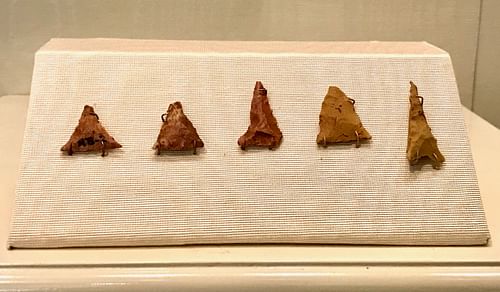
The success of Cahokia led to its eventual downfall and abandonment, however, as overpopulation depleted resources and efforts to improve the peoples’ lives wound up making them worse. The city’s water supply was a creek (Canteen Creek) which the Cahokians diverted so it joined another (modern-day Cahokia Creek), bringing more water to the city to supply the growing population. The merging of the two streams also allowed woodcutters to send their logs downstream to the city instead of having to carry them further and further distances as the forest receded due to harvesting.
With tree cover and root systems dwindling upland from the city, heavy rains had nothing to absorb them and so ran into the creeks and streams, causing flooding, especially of the now-merged creeks, which destroyed crops. The stockade built to protect the city from floods was useless since the merged creeks brought the water directly into the city and so homes were also damaged.
Recognizing their mistake, the Cahokians began replanting the forest but it was too little too late. The clergy, who were held responsible for the peoples’ misfortunes as they had obviously failed to interpret the will of the gods and placate them, initiated reforms, abandoning the secretive rituals on top of Monks Mound for full transparency in front of the populace on the plateau but this effort, also, came too late and was an ineffective gesture. The clergy, who were all of the upper class and, as noted, had established a hereditary system of control, seem to have tried to save face and retain power instead of admitting they had somehow failed and seeking forgiveness and this, coupled with the other difficulties, seems to have led to civil unrest.
An earthquake at some point in the 13th century toppled buildings and, at the same time, overpopulation led to unsanitary conditions and the spread of disease. Some scholars now believe that people were repeatedly invited to take up residence in the city to replace those who had died and graves containing obvious victims of human sacrifice suggest that the people were becoming desperate for help from their gods (although human sacrifice was practiced earlier as seen in the tomb of the ruler referred to as Birdman). Evidence of civil war or at least large-scale social unrest suggests some sort of violent clash c. 1250 CE and although attempts were made to repair the damage done by floods and the earthquake, whatever central authority had maintained order previously seems to have fallen apart; by c. 1350 CE the city had been abandoned.
Conclusion
When the mounds of Cahokia were first noted by Europeans in the 19th century, they were regarded as natural formations by some and the work of various European or Asiatic peoples by others. Mann notes:
Nineteenth century writers attributed the mound complexes to, among others, the Chinese, the Welsh, the Phoenicians, the lost nation of Atlantis, and various biblical personages. A widely touted theory assigned authorship to Scandinavian emigres, who later picked up stakes, moved to Mexico, and became the Toltecs. (289-290)
As with the Maya when they were “discovered”, European and American writers refused to believe the mounds were created by Native Americans even though one of the greatest American intellectuals of the 18th century, Thomas Jefferson, had examined the mounds and proclaimed them of “Indian origin”.
The great mystery of who the builders had been was amplified by the question of where they had gone. The “mysterious” disappearance of the people of Cahokia is still discussed by some writers and video producers in the present day. There is no mystery to their disappearance, however, nor was the site permanently abandoned in c. 1350 CE.
Recent work done at Cahokia shows conclusively that the city was reinhabited by the tribes of the Illinois Confederacy. Doctoral student A.J. White of University of California, Berkeley, spearheaded the team which established that Cahokia was repopulated by the 1500’s and maintained a steady population through the 1700’s when European-borne disease, climate change, and warfare finally led to the decline and abandonment of the city, although some people continued to live there up into the early 1800’s. These people, however, had no idea who had built the mounds, leaving the question open for speculation.
Although Cahokia was known to 19th century scholars, no professional excavation of the site was attempted until the 1960’s and, since then, archaeological work there has been ongoing. As noted, Cahokia today is a UNESCO World Heritage Site open to the public with an interpretive center and museum, walkways and stairs between and on the mounds, and events held to commemorate, honor, and teach the history of the people who once lived there.
